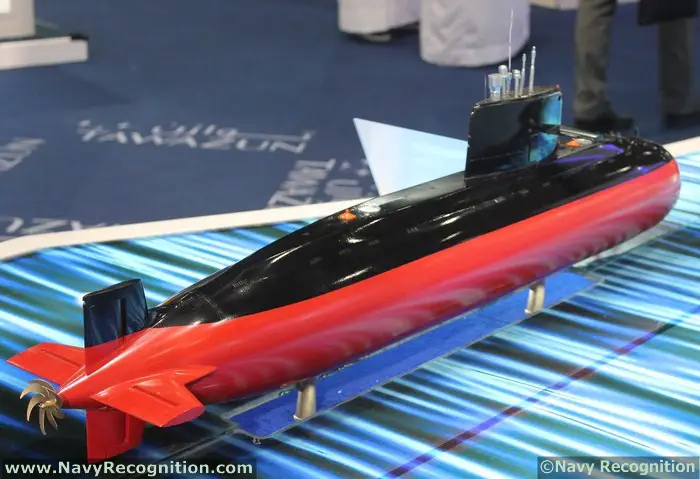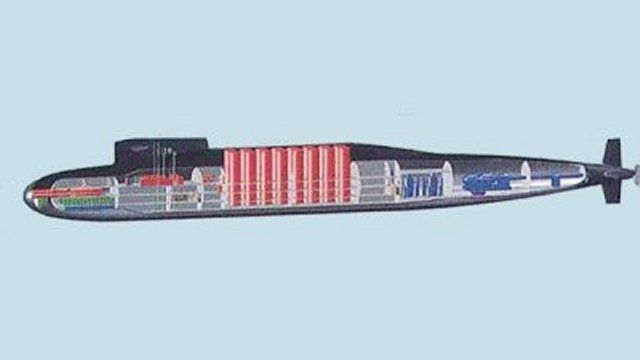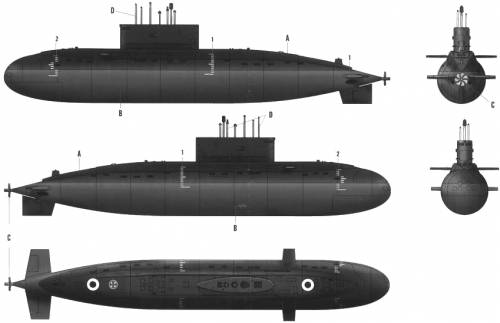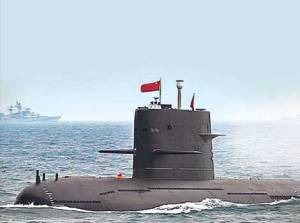Manticore
RETIRED MOD

- Joined
- Jan 18, 2009
- Messages
- 10,115
- Reaction score
- 114
- Country
- Location
A short chronological introduction 
To trace the developments of China’s submarines fleet we first have to trace the history of Russian submarines. This is another area where Russia has been so ideologically bound up with ‘socialism’ in the past that it has compromised its present day security by blindly sharing/selling its technology.
Pictured above is a Whiskey class Soviet submarine, designed in the mid 1940s and built between 1940 and 1958. This particular vessel (Sub P112) was sold recently (2011) for US $ 550,000. This article covers only conventional diesel-electric boats.
Early Years
Pre-war Russian submarines spanned vessels varying in displacement from those of a little over 200 tons to over 1,000 tons. Evidence exists to suggest that the Soviet Union and Germany were as early as the Weimar Republic (banned under the Versailles Treaty) co-operating on submarine design and construction.
Between 1929 and 1945 Russia had approx. 270 submarines, most were designed for the Baltic and coastal waters (see Table below).
 Thus China’s submarine fleet only began in 1954 with the gift of Soviet vessels. However, before then Russiawas to enjoy a technological boost in 1945 with the surrender of Germanyand the articles in the Potsdam Agreement that gave it access to German technology on land, sea and air.
Thus China’s submarine fleet only began in 1954 with the gift of Soviet vessels. However, before then Russiawas to enjoy a technological boost in 1945 with the surrender of Germanyand the articles in the Potsdam Agreement that gave it access to German technology on land, sea and air.

A single Type XXIII U-Boat was allocated to the Soviet Union under the terms of the Agreement but Russia was well placed to salvage other U-Boatsfrom Baltic and Eastern Europe countries overrun by the Red Army.
Left: Type XXI U-boat (U-2540) sometime after 1945.
Of particular interest to Britain and America and therefore to Russia were the Walter designed U-boats – the Type XXIII and Type XXI known as the Elektroboot U-boats – with their streamlining, higher underwater speeds and long range. Type XXIII and Type XXI were futuristic and even today it would not be unresonable to believe that these craft could have been built 10 or 15 years ago. By enlarging this image (click on picture) it is fascinating to think that these clean and attractive lines were first propounded over 70 years ago.
The latter, Type XXI, could travel submerged for two or three days before recharging batteries (a 5 hours process using a Snorkel). There are more details of U-boat variants can be found at Appendix A below.
Post 1945
At the end of World War II, the Soviets obtained several Type XXIs, from which they were able to obtain certain key technologies. These technologies assisted in the design of the Zuluclass and Whiskey class (NATO codes). Further improvements on the design led to the Romeo class.
The Type XXI and XXIII U-boats revolutionised Russian post-war submarine design. The Type XXI U-boat was almost as fast submerged (13 knots) as it was on the surface (15 knots) and someU-boats designs using the Walther hydrogen peroxide system (an unstable gas), were actually faster submerged than on the surface (15 knots vs 17 knots).
 The Romeo class of Soviet diesel-electric submarine (Project 633) can trace its origins and streamlining to the World War II Elektroboot and to the Walter designs (as indeed, can the streamlined USS Nautilus, SSN-571).
The Romeo class of Soviet diesel-electric submarine (Project 633) can trace its origins and streamlining to the World War II Elektroboot and to the Walter designs (as indeed, can the streamlined USS Nautilus, SSN-571).
Right: Romeo class Soviet Sub and Chinese Type 033
Russia produced 133 Romeo class conventional attack submarines – 29 are still in use but not operationally. ‘Attack submarines’ are designed and deployed to sink other submarines and not merely to target surface ships (eavesdropping is another of their other roles).
Nations that also took delivery of this 1,800 ton class were former Warsaw Pact members and several Middle Eastern countries, e.g. Iran, Syria, Egypt, and Algeria. Approx. 75 of these 1,830 ton Soviet-built subs have been scrapped.
The bulbous nose (bow) seen on the Romeo class pictured above housed the Soviet built Hercules or Tamir-5 high-frequency sonar for active / passive search and attack. Later variants are also fitted with Sintra DUUX 5, a low frequency sonar for passive ranging and intercept. Yet later variants were reported to have had weapon systems removed to accommodate surveillance and electronic intelligence (ELINT) equipment for special reconnaissance missions. [1]
Nuclear Option
Following the 1954 gifts from Russia, Chairman Mao visited Jiangnan shipyard (i.e. Shanghai) in Jan 1956 where the PRC’s very first submarine was being built from a Soviet kit. China would eventually go on to build 21 of these Soviet “Whiskey” class boats which were the predecessors of the Romeo class.
 Left: Soviet“Whiskey” class
Left: Soviet“Whiskey” class
Soviet “Whiskey”class submarine displaced 1,350 tons submerged, had a range 13,500 nautical miles and so were ideal for the vast distances of the Pacifice. Between 1949 and 1958 a total of 236 Whiskeyclass submarine were built incorporating many variants, e.g. Mark 1 to Mark V. It was succeeded by the Romeo class with a similar range, i.e. 13,500 naut. miles.
The Whiskey class and Romeo class must be seen as the transitional designs – the stop gaps – from World War II technology to the demands made by the Cold War of a nuclear missile strike capability.
It is remarkable to read, in Chinese sourced military and political journals in the late 1950s (and from US / CIA sources), of the apparent interest in nuclear powered ships especially submarines atthis early stage. This can only be a reflection of the progress made by the US Navy (USS Nautilus, SSN-571), and the ambitions of theUSSR.
The suspicion is thatthe first fully submerged circumnavigation of the globe by the atomic powered submarine USS Triton, in May 1960, made have riveted attention to the potential that nuclear propulsion held. (USS Triton maintained a steady submerged speed of 21 knots for nearly three months).
The party line in China appears to be that nuclear propulsion for submarines was adopted as a national priority by Mao himself. This may be true but Mao as a visionary and still a strategist in all things at the age of 63 is stretching credibility (Mao was born in 1893). Two years later, in 1958, an ailing Mao announced the “Great Leap Forward”, anattempt to increase agricultural and industrial production by Stalinist ‘collectives’ but which failed hopelessly and resulted in famines.
Shortly afterwards Mao retired from the post of Chairman of the People’s Republic of China and was replaced as head of state by Liu Shaoqi – though Mao continued to wield political influence e.g. sponsoring the Cultural Revolution.

To trace the developments of China’s submarines fleet we first have to trace the history of Russian submarines. This is another area where Russia has been so ideologically bound up with ‘socialism’ in the past that it has compromised its present day security by blindly sharing/selling its technology.
Pictured above is a Whiskey class Soviet submarine, designed in the mid 1940s and built between 1940 and 1958. This particular vessel (Sub P112) was sold recently (2011) for US $ 550,000. This article covers only conventional diesel-electric boats.
Early Years
Pre-war Russian submarines spanned vessels varying in displacement from those of a little over 200 tons to over 1,000 tons. Evidence exists to suggest that the Soviet Union and Germany were as early as the Weimar Republic (banned under the Versailles Treaty) co-operating on submarine design and construction.
Between 1929 and 1945 Russia had approx. 270 submarines, most were designed for the Baltic and coastal waters (see Table below).
 Thus China’s submarine fleet only began in 1954 with the gift of Soviet vessels. However, before then Russiawas to enjoy a technological boost in 1945 with the surrender of Germanyand the articles in the Potsdam Agreement that gave it access to German technology on land, sea and air.
Thus China’s submarine fleet only began in 1954 with the gift of Soviet vessels. However, before then Russiawas to enjoy a technological boost in 1945 with the surrender of Germanyand the articles in the Potsdam Agreement that gave it access to German technology on land, sea and air.
A single Type XXIII U-Boat was allocated to the Soviet Union under the terms of the Agreement but Russia was well placed to salvage other U-Boatsfrom Baltic and Eastern Europe countries overrun by the Red Army.
Left: Type XXI U-boat (U-2540) sometime after 1945.
Of particular interest to Britain and America and therefore to Russia were the Walter designed U-boats – the Type XXIII and Type XXI known as the Elektroboot U-boats – with their streamlining, higher underwater speeds and long range. Type XXIII and Type XXI were futuristic and even today it would not be unresonable to believe that these craft could have been built 10 or 15 years ago. By enlarging this image (click on picture) it is fascinating to think that these clean and attractive lines were first propounded over 70 years ago.
The latter, Type XXI, could travel submerged for two or three days before recharging batteries (a 5 hours process using a Snorkel). There are more details of U-boat variants can be found at Appendix A below.
Post 1945
At the end of World War II, the Soviets obtained several Type XXIs, from which they were able to obtain certain key technologies. These technologies assisted in the design of the Zuluclass and Whiskey class (NATO codes). Further improvements on the design led to the Romeo class.
The Type XXI and XXIII U-boats revolutionised Russian post-war submarine design. The Type XXI U-boat was almost as fast submerged (13 knots) as it was on the surface (15 knots) and someU-boats designs using the Walther hydrogen peroxide system (an unstable gas), were actually faster submerged than on the surface (15 knots vs 17 knots).
 The Romeo class of Soviet diesel-electric submarine (Project 633) can trace its origins and streamlining to the World War II Elektroboot and to the Walter designs (as indeed, can the streamlined USS Nautilus, SSN-571).
The Romeo class of Soviet diesel-electric submarine (Project 633) can trace its origins and streamlining to the World War II Elektroboot and to the Walter designs (as indeed, can the streamlined USS Nautilus, SSN-571).Right: Romeo class Soviet Sub and Chinese Type 033
Russia produced 133 Romeo class conventional attack submarines – 29 are still in use but not operationally. ‘Attack submarines’ are designed and deployed to sink other submarines and not merely to target surface ships (eavesdropping is another of their other roles).
Nations that also took delivery of this 1,800 ton class were former Warsaw Pact members and several Middle Eastern countries, e.g. Iran, Syria, Egypt, and Algeria. Approx. 75 of these 1,830 ton Soviet-built subs have been scrapped.
The bulbous nose (bow) seen on the Romeo class pictured above housed the Soviet built Hercules or Tamir-5 high-frequency sonar for active / passive search and attack. Later variants are also fitted with Sintra DUUX 5, a low frequency sonar for passive ranging and intercept. Yet later variants were reported to have had weapon systems removed to accommodate surveillance and electronic intelligence (ELINT) equipment for special reconnaissance missions. [1]
Nuclear Option
Following the 1954 gifts from Russia, Chairman Mao visited Jiangnan shipyard (i.e. Shanghai) in Jan 1956 where the PRC’s very first submarine was being built from a Soviet kit. China would eventually go on to build 21 of these Soviet “Whiskey” class boats which were the predecessors of the Romeo class.
 Left: Soviet“Whiskey” class
Left: Soviet“Whiskey” classSoviet “Whiskey”class submarine displaced 1,350 tons submerged, had a range 13,500 nautical miles and so were ideal for the vast distances of the Pacifice. Between 1949 and 1958 a total of 236 Whiskeyclass submarine were built incorporating many variants, e.g. Mark 1 to Mark V. It was succeeded by the Romeo class with a similar range, i.e. 13,500 naut. miles.
The Whiskey class and Romeo class must be seen as the transitional designs – the stop gaps – from World War II technology to the demands made by the Cold War of a nuclear missile strike capability.
It is remarkable to read, in Chinese sourced military and political journals in the late 1950s (and from US / CIA sources), of the apparent interest in nuclear powered ships especially submarines atthis early stage. This can only be a reflection of the progress made by the US Navy (USS Nautilus, SSN-571), and the ambitions of theUSSR.
The suspicion is thatthe first fully submerged circumnavigation of the globe by the atomic powered submarine USS Triton, in May 1960, made have riveted attention to the potential that nuclear propulsion held. (USS Triton maintained a steady submerged speed of 21 knots for nearly three months).
The party line in China appears to be that nuclear propulsion for submarines was adopted as a national priority by Mao himself. This may be true but Mao as a visionary and still a strategist in all things at the age of 63 is stretching credibility (Mao was born in 1893). Two years later, in 1958, an ailing Mao announced the “Great Leap Forward”, anattempt to increase agricultural and industrial production by Stalinist ‘collectives’ but which failed hopelessly and resulted in famines.
Shortly afterwards Mao retired from the post of Chairman of the People’s Republic of China and was replaced as head of state by Liu Shaoqi – though Mao continued to wield political influence e.g. sponsoring the Cultural Revolution.
Ego clash
China’s long march towards naval self-sufficiency and her longer term aim of greater parity with the navies of the West halted when Mao metaphorically burnt China’s bridges with Russiain the Sino-Soviet split. Mao became openly critical of Nikita Khrushchev’s interpretation of the direction of world communism and how socialism should develop in theUSSR.
Personality and the cult of personality was the Achilles heel of China. From the 1960s to the late 1970s China was held back first by the nihilistic behaviour of the Red Guard and then the destruction influence of the ‘Gang of Four’ (circa 1973). Only with the death of Mao (1976) did China gradually return to some semblance of a normal state. [2]
While all this was going on Chinabegan producing Soviet-designedRomeo class submarines in significant quantities between 1965 and the early 1980s. Eventually the PLAN had more than 60 of these boats in service. It has been estimated that more than 100 the Type 033 were built by the PLAN and some exported.
NATO’s codename of Romeo class diesel-electronic submarine was known to the Russia’s as Project 633. They were armed with conventional torpedoes and the transfer of technology to China began in Feb 1959.
Project 629 submarines, known to NATO as Golf class were diesel-electric powered submarine but carried missiles. [3] The illustration below shows the missiles were housed in the conning towr (referred to in american literatire as the ‘sail’), part of the boat
The two submarine types were to be built in Chinaas Type 6633(later known as Type 033) and Type 6631 (later known as Type 031) respectively.
Type 033) and Type 6631 (later known as Type 031) respectively.
Left: Golf class
To clarify – Type 033 is the Chinese designation and carried torpedoes and Type 031 carried both torpedoes and missiles (Type 6622 / Chinese 033 = Romeo class and 6631 = Golf class, respectively).
Note too how submariens of this era still retained the bow indicating much of their operatinal time could be expected to be spent on the surface. With the advent of nuclear power the beed for a surface ship bow disappears.
Defence source point to Chinese 033 as enhanced Romeo class insofar as the 033 had better sonar and a longer range. Both the 033 and 031 projects suffered from the Sino-Soviet split in as much that although China managed to launch its fistRomeo type sub in 1965 it was not serviceable until 1970.
suffered from the Sino-Soviet split in as much that although China managed to launch its fistRomeo type sub in 1965 it was not serviceable until 1970.
Left: Artist impression of a Golf class firing a missile
In terms of an offensive platform it is regarded as a ‘noisy’ vessel, of an ageing design, incapable of operating safely in deep water, e.g. Pacific and suitable only for coastal defence and patrol duties. By the end of the 1990s chain has decommissioned all the craft although 4 were sold to North Korea.
The original plan was for the production yards to use Soviet-supplied kits initially, and then gradually increase the indigenous elements untilChinacould build the submarines independently.
China’s long march towards naval self-sufficiency and her longer term aim of greater parity with the navies of the West halted when Mao metaphorically burnt China’s bridges with Russiain the Sino-Soviet split. Mao became openly critical of Nikita Khrushchev’s interpretation of the direction of world communism and how socialism should develop in theUSSR.
Personality and the cult of personality was the Achilles heel of China. From the 1960s to the late 1970s China was held back first by the nihilistic behaviour of the Red Guard and then the destruction influence of the ‘Gang of Four’ (circa 1973). Only with the death of Mao (1976) did China gradually return to some semblance of a normal state. [2]
While all this was going on Chinabegan producing Soviet-designedRomeo class submarines in significant quantities between 1965 and the early 1980s. Eventually the PLAN had more than 60 of these boats in service. It has been estimated that more than 100 the Type 033 were built by the PLAN and some exported.
NATO’s codename of Romeo class diesel-electronic submarine was known to the Russia’s as Project 633. They were armed with conventional torpedoes and the transfer of technology to China began in Feb 1959.
Project 629 submarines, known to NATO as Golf class were diesel-electric powered submarine but carried missiles. [3] The illustration below shows the missiles were housed in the conning towr (referred to in american literatire as the ‘sail’), part of the boat
The two submarine types were to be built in Chinaas Type 6633(later known as
 Type 033) and Type 6631 (later known as Type 031) respectively.
Type 033) and Type 6631 (later known as Type 031) respectively.Left: Golf class
To clarify – Type 033 is the Chinese designation and carried torpedoes and Type 031 carried both torpedoes and missiles (Type 6622 / Chinese 033 = Romeo class and 6631 = Golf class, respectively).
Note too how submariens of this era still retained the bow indicating much of their operatinal time could be expected to be spent on the surface. With the advent of nuclear power the beed for a surface ship bow disappears.
Defence source point to Chinese 033 as enhanced Romeo class insofar as the 033 had better sonar and a longer range. Both the 033 and 031 projects
 suffered from the Sino-Soviet split in as much that although China managed to launch its fistRomeo type sub in 1965 it was not serviceable until 1970.
suffered from the Sino-Soviet split in as much that although China managed to launch its fistRomeo type sub in 1965 it was not serviceable until 1970.Left: Artist impression of a Golf class firing a missile
In terms of an offensive platform it is regarded as a ‘noisy’ vessel, of an ageing design, incapable of operating safely in deep water, e.g. Pacific and suitable only for coastal defence and patrol duties. By the end of the 1990s chain has decommissioned all the craft although 4 were sold to North Korea.
The original plan was for the production yards to use Soviet-supplied kits initially, and then gradually increase the indigenous elements untilChinacould build the submarines independently.
Developments in the 1970s
In the 1970s, approximately 20% of China’s defence budget was allocated to naval forces resulting in a dramatic growth in the Navy. The conventional submarine force increased from 35 to 100 boats, but the longer term ambition was still one of a submarine powered by nuclear technology.
The true extent of how daunting this challenge represented only became fully clear to the Chinese when Moscow refused Peking’s specific request to share nuclear propulsion technology. The rejection was made on the grounds that it would be ‘premature’ for the PLAN. A valid point consideringChina’s lack of experience with underwater craft and the deadly accidents caused by bad luck and casualness.
In the 1970s, approximately 20% of China’s defence budget was allocated to naval forces resulting in a dramatic growth in the Navy. The conventional submarine force increased from 35 to 100 boats, but the longer term ambition was still one of a submarine powered by nuclear technology.
The true extent of how daunting this challenge represented only became fully clear to the Chinese when Moscow refused Peking’s specific request to share nuclear propulsion technology. The rejection was made on the grounds that it would be ‘premature’ for the PLAN. A valid point consideringChina’s lack of experience with underwater craft and the deadly accidents caused by bad luck and casualness.































































